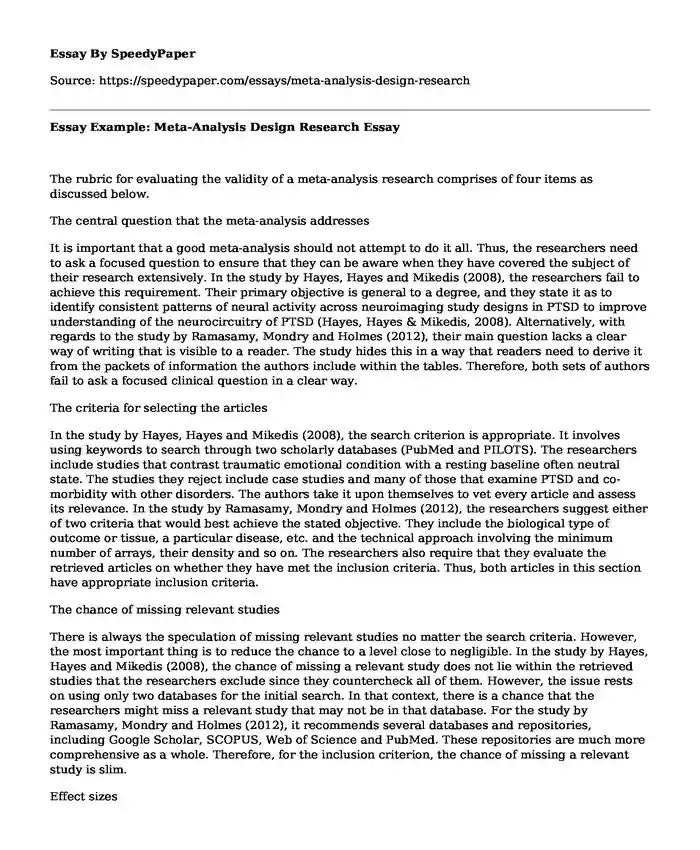
| Type of paper: | Essay |
| Categories: | Data analysis Research |
| Pages: | 3 |
| Wordcount: | 724 words |
The rubric for evaluating the validity of a meta-analysis research comprises of four items as discussed below.
The central question that the meta-analysis addresses
It is important that a good meta-analysis should not attempt to do it all. Thus, the researchers need to ask a focused question to ensure that they can be aware when they have covered the subject of their research extensively. In the study by Hayes, Hayes and Mikedis (2008), the researchers fail to achieve this requirement. Their primary objective is general to a degree, and they state it as to identify consistent patterns of neural activity across neuroimaging study designs in PTSD to improve understanding of the neurocircuitry of PTSD (Hayes, Hayes & Mikedis, 2008). Alternatively, with regards to the study by Ramasamy, Mondry and Holmes (2012), their main question lacks a clear way of writing that is visible to a reader. The study hides this in a way that readers need to derive it from the packets of information the authors include within the tables. Therefore, both sets of authors fail to ask a focused clinical question in a clear way.
The criteria for selecting the articles
In the study by Hayes, Hayes and Mikedis (2008), the search criterion is appropriate. It involves using keywords to search through two scholarly databases (PubMed and PILOTS). The researchers include studies that contrast traumatic emotional condition with a resting baseline often neutral state. The studies they reject include case studies and many of those that examine PTSD and co-morbidity with other disorders. The authors take it upon themselves to vet every article and assess its relevance. In the study by Ramasamy, Mondry and Holmes (2012), the researchers suggest either of two criteria that would best achieve the stated objective. They include the biological type of outcome or tissue, a particular disease, etc. and the technical approach involving the minimum number of arrays, their density and so on. The researchers also require that they evaluate the retrieved articles on whether they have met the inclusion criteria. Thus, both articles in this section have appropriate inclusion criteria.
The chance of missing relevant studies
There is always the speculation of missing relevant studies no matter the search criteria. However, the most important thing is to reduce the chance to a level close to negligible. In the study by Hayes, Hayes and Mikedis (2008), the chance of missing a relevant study does not lie within the retrieved studies that the researchers exclude since they countercheck all of them. However, the issue rests on using only two databases for the initial search. In that context, there is a chance that the researchers might miss a relevant study that may not be in that database. For the study by Ramasamy, Mondry and Holmes (2012), it recommends several databases and repositories, including Google Scholar, SCOPUS, Web of Science and PubMed. These repositories are much more comprehensive as a whole. Therefore, for the inclusion criterion, the chance of missing a relevant study is slim.
Effect sizes
Absolute effect size is the deviation between the mean outcomes of two different intervention groups (Sullivan & Feinn, 2012). It can also be regarded to as the standardized measure of the effect. The effect size is a primary finding of a quantitative study. Since the r-value informs the reader of the existence of an effect, it cannot quantify its size; thus, the relevance of the effect size (Sullivan & Feinn, 2012). In the study by Ramasamy, Mondry and Holmes (2012), it involves no real data but main recommendations on how to conduct the examination. Therefore, there are no sizes to quantify. For the study by Hayes, Hayes and Mikedis (2008), the authors fail to present both the effect sizes and the r-value from the data they gather. Hence, it is not easy to compare the effect of the intervention from the control group that is initially designed. In this case, this is a fail on their part.
References
Hayes, J. P., Hayes, S. M., & Mikedis, A. M. (2012). Quantitative meta-analysis of neural activity in posttraumatic stress disorder. Biology of Mood & Anxiety Disorders, 2(9), 1-13.
Ramasamy, A., Mondry, A., Holmes, C. C., & Altman, D. G. (2008, September). Key Issues in Conducting a Meta-Analysis of Gene Expression Microarray Datasets. PLoS Medicine, 5(9), 1320-1332.
Sullivan, G. M., & Feinn, R. (2012, September). Using Effect Sizeor Why the P Value Is Not Enough. Journal of Graduate Medical Education, 279282.
Cite this page
Essay Example: Meta-Analysis Design Research. (2019, Oct 08). Retrieved from https://speedypaper.com/essays/meta-analysis-design-research
Request Removal
If you are the original author of this essay and no longer wish to have it published on the SpeedyPaper website, please click below to request its removal:
- HR Essay Sample: Personnel Handling, Motivation and Communication Strategies
- Reengineering the Corporation - Book Review Essay Example
- The Purpose and Analysis Essay of "The Birthmark" by Nathaniel Hawthorne
- Essay Sample: Image of Women in the Selected Stories of Lu Xun and in the Joy Luck Club
- Free Essay: Why Online Learning is Effective
- Essay Sample on Views of "The Good Life" By Marcus and Confucius
- Free Essay: Installation of Solar Panels in CUNY
Popular categories




